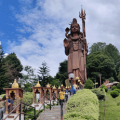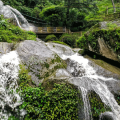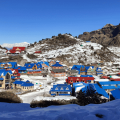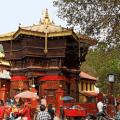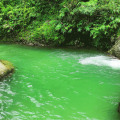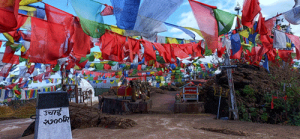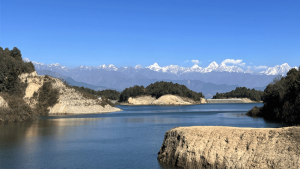Swayambhunath is famous for different names all over the world. People call it Swoyambhu, Swayambhunath Temple, Swayambhunath Stupa, or Swoyambhu Mahachaitya. This temple lies in the capital city of Nepal, Kathmandu. Also, people name this place Monkey Temple. We can better call this place a religious complex on the hill of Kathmandu Valley. Likewise, it is a holy place for Hindus and Buddhists. This holy place is a significant pilgrimage site for Buddhists and Hindus. Swayambhunath is a popular tourist attraction in not only the capital city, Kathmandu but in Nepal. Moreover, this holy area is located at the top of a hill in the Kathmandu Valley. Besides, Swayambhunath Temple is a UNESCO World Heritage Site. Consequently, it is a cultural landmark of the country. Likewise, this holy temple area offers panoramic views of the Kathmandu Valley and the mountain ranges.
As this holy place is one of the best places to visit in Kathmandu. The temple area consists of many Stupas. There are varieties of shrines and temples. People believe they are back from the Licchavi period. Recently, the management committee and the government have added a Tibetan monastery, museum, and library in the temple area. The main attraction of the area is the huge Stupa. Likewise, the stupa has Buddha’s eyes painted on it. Besides, several antique shops, hotels, and restaurants are available in the stupa area. In this blog, we are going to see deeper into the history, architecture, symbolism, and significance of the Swayambhunath temple. Correspondingly, we will explore its evolution from ancient times to the present day.
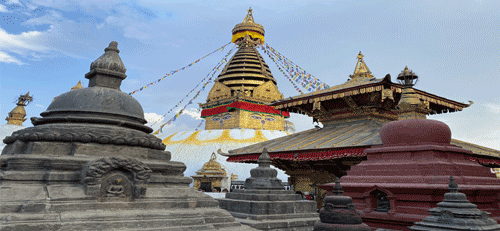
Mythology on the formation of Swayambhunath Temple
There are many myths and beliefs about the origin of Swayambhunath. But according to tradition, this area has been an important religious site for Hindus and Buddhists for over 2000 years. According to Swayambhu Purana, the Kathmandu Valley was a lake fully covered with water. Manjushri, a renowned personality in Buddhism was the person who drained the water of Kathmandu Valley. History tells us that Manjushri made this Valley a suitable living place.
According to myths, at the time of Manjushri, a large and beautiful lotus grew in the middle of the lake. Manjushri had a vision of human settlement at the lake after the water drained out. So, he cut a gorge at Chovar and drained all the water out. After that, the lotus was transformed into a hill. Likewise, the stupa is exactly at the place where the lotus was. History tells us that the lotus flower had the essence of Lord Buddha, and the site became a sacred pilgrimage site.
History
After the formation of the stupa, various religious buildings were constructed on the site over time. These constructions included stupas, temples, and shrines. Besides, the temple and buildings in the temple area were damaged and destroyed many times by earthquakes, fires, and invasions. Although, it was always reconstructed and restored.
Malla Kings of the Kathmandu Valley have a major role in the reconstruction and renovation of the temple area. This was during the 14th century. Likewise, a new stupa was made, and the addition of prayer wheels, and construction of statues as well. With time, Swayambhunath became an important center of Buddhist worship and pilgrimage.
Visitors can find a large number of monkeys living around the areas of the temple. People believe they are holy because Manjushri, the bodhisattva of wisdom and learning, was raising the hill exactly where Swayambhunath Stupa lies today. As Manjushri was supposed to leave his hair short, he made it grow long. On the long air grew many lice. Further, there is a belief that these monkeys are the transformation of the lice of Manjushri.

Architecture and Symbolism
The architecture of Swayambhunath Temple is a fusion of Hindu and Buddhist architecture. Likewise, this temple reflects the cultural and religious diversity of Nepal. Correspondingly, the center of attraction in this area is a huge Stupa located at the hilltop. This stupa is big and white painted with a golden spire and a pinnacle. This represents the four elements – earth, water, fire, and air. Equally, the stupa is painted with the eyes of Lord Buddha in all four directions. There is a huge Gajur at the top of the stupa. A circular path surrounds the stupa with spinning wheels. Generally, the path is for believers to walk around the stupa and offer prayers to the god. Usually, this praying is done by walking around the Stupa, spinning the wheels, and chanting Mantras.
The base of Swayambhunath Temple contains a pair of eyes. However, people believe the eyes of Buddha are his omnipresence and wisdom. Also, the eyes are painted on all four sides of the holy stupa. Identically, between them, there is a nose-shaped symbol which is beautiful to watch. This symbol represents the Nepalese character for number one. Moreover, above the eyes, there is a third eye in the stupa. This eye symbolizes the wisdom and enlightenment of Buddha.
There are many other smaller stupas, temples, and monasteries near the temple. Indeed, these are decorated with colorful prayer flags, paintings, and carvings. The main features of the temple are the four pairs of lions. These lions are carved on the stupa’s base and represent strength, power, and courage. Moreover, the lions face four directions – north, south, east, and west. People believe these lions guard the stupa and its treasures.
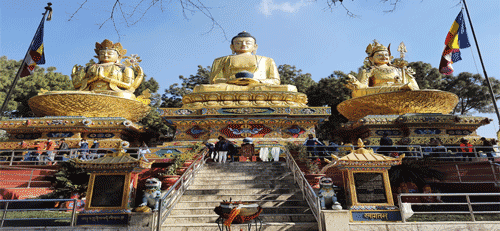
Significance and Spirituality
The Swayambhunath Temple is one of the most significant religious sites for Hindus and Buddhists in Nepal. Likewise, this temple is enlisted as a UNESCO World Heritage site. As it is significant for both Hindus and Buddhists, it symbolizes religious harmony in Nepal. Meanwhile, this temple is famous as Monkey Temple because a large number of monkeys are available around the temple area.
There is a huge forest(Jungle) around the temple premises. Likewise, this forest is home to a large number of monkeys. Visitors visiting this stupa area encounter the monkeys. There is an interesting part of visiting this temple. If visitors are roaming around the temple premises with food in their hands, the monkeys are keen on snatching the food from the visitor’s hands. Similarly, a lot of tourists enjoy the monkey feeding on the temple premises. Moreover, you can find many local photographers for taking beautiful pictures of the Swayambhu Temple behind.
For Buddhists
Swayambhunath temple is a sacred site for Buddhists. Buddhists believe this place is the birthplace of the Vajrayana tradition of Buddhism. Moreover, this temple contains remains of the Buddha and other important Buddhist masters. This temple is a popular pilgrimage site for Buddhists in Nepal. Pilgrims visit this holy place to offer prayers and perform rituals.
For Hindus
Swayambhunath Temple is significant for Hindus as well because Hindus believe this place is the home of the Hindu goddess Vajrayogini. Likewise, there is a belief that the temple is also associated with Lord Shiva. Myths say that Lord Shiva lived on the hill where the temple is located. Particularly, the temple is a popular pilgrimage site for Hindus in Nepal. Hindu pilgrims visit this place to offer prayers and seek blessings.
More about the Swayambhunath area
Swayambhunath Temple is also significant for its role in the history of Nepal. The temple has an important role in the unification of Nepal. It was during the 18th century when King Prithvi Narayan Shah conquered the Kathmandu valley.
When King Prithvi Narayan Shah conquered the Kathmandu Valley, three different kingdoms: Kathmandu, Patan, and Bhaktapur were ruling the Kathmandu Valley. King Prithvi Narayan Shah of Gorkha had a vision of a united Nepal. There is a belief that King Prithvi Narayan Shah received a divine message from Swayambhunath Temple. Certainly, this message encouraged him to invade the Kathmandu Valley. In the divine message, a monk came from the east and liberated the Valley from the oppression of the Mallas. King Prithvi Narayan Shah interpreted the message to mean that he was a monk. And King Prithvi Narayan Shah thought of conquering the Kathmandu Valley. After his victory, King Shah visited Swayambhunath Temple to offer thanks and pray for the success and prosperity of his new kingdom.
The Swayambhunath temple is an important pilgrimage site for Buddhists. Pilgrims come from all over the world to pay homage to the stupa and seek spiritual enlightenment. Similarly, the temple is full of Nepal’s cultural and religious heritage. And also, it is a unique blend of Hindu and Buddhist traditions. Moreover, the temple is not only a place of worship but also a cultural and social hub. Visitors from inside and outside Nepal gather to celebrate festivals, exchange ideas, and engage in community activities.
The Swayambhunath temple is home to several monasteries and schools of Buddhism. Likewise, many monks study, meditate, and practice their faith. The temple area also contains a museum, which showcases Buddhist art, artifacts, and history.
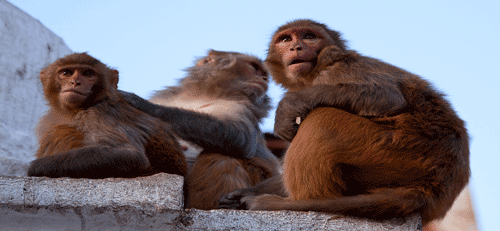
Highlights and attractions at Swayambhunath
- Swayambhunath Stupa with dome-shaped base and pentagon-shaped toran above
- Panoramic view of mountains and Kathmandu Valley from the temple
- Buddha Park
- Many small stupas and monasteries around the temple
- 365 stone steps ladder to reach the temple
- Swayambhu Buddhist Museum
- Statue of peace
- Gold-plated Vajra ‘thunderbolt’ in the east side of the temple
- Lord Buddha’s statue on the west side of the temple
- Sleeping Buddha near the temple area
- Number of monkeys in the temple area
- Swimming monkeys during summer
You May Also Like To Read About
How to reach Swayambhunath Temple
Swayambhunath Temple is at a distance of 3.5 km from Ratnapark Bus Park which is near Thamel. It takes about 20 minutes in a vehicle from Ratnapark to reach the destination.
The Swayambhunath temple has two access points. Firstly, a long staircase leads directly to the main place of the temple where the stupa is. This staircase is from the top of the hill to the east. Secondly, a car road around the hill from the south leading to the south-west entrance.
Google Map of Swayambhunath Temple
Swayambhunath Temple is famous because it is one of the sacred places for Hindus and Buddhists.
The old name of Swayabhu Temple is Swoyambhu Mahachaitya.
This is because the forest around the temple is home to a large number of monkeys.
Swayambhunath Temple lies in the capital city of Nepal, Kathmandu.
Conclusion
Swayambhunath Temple plays an essential role in the religious and cultural life of Nepal. It remains a popular pilgrimage site for both Hindus and Buddhists. And also, there is a huge significance of the temple in Nepal’s history and culture.



